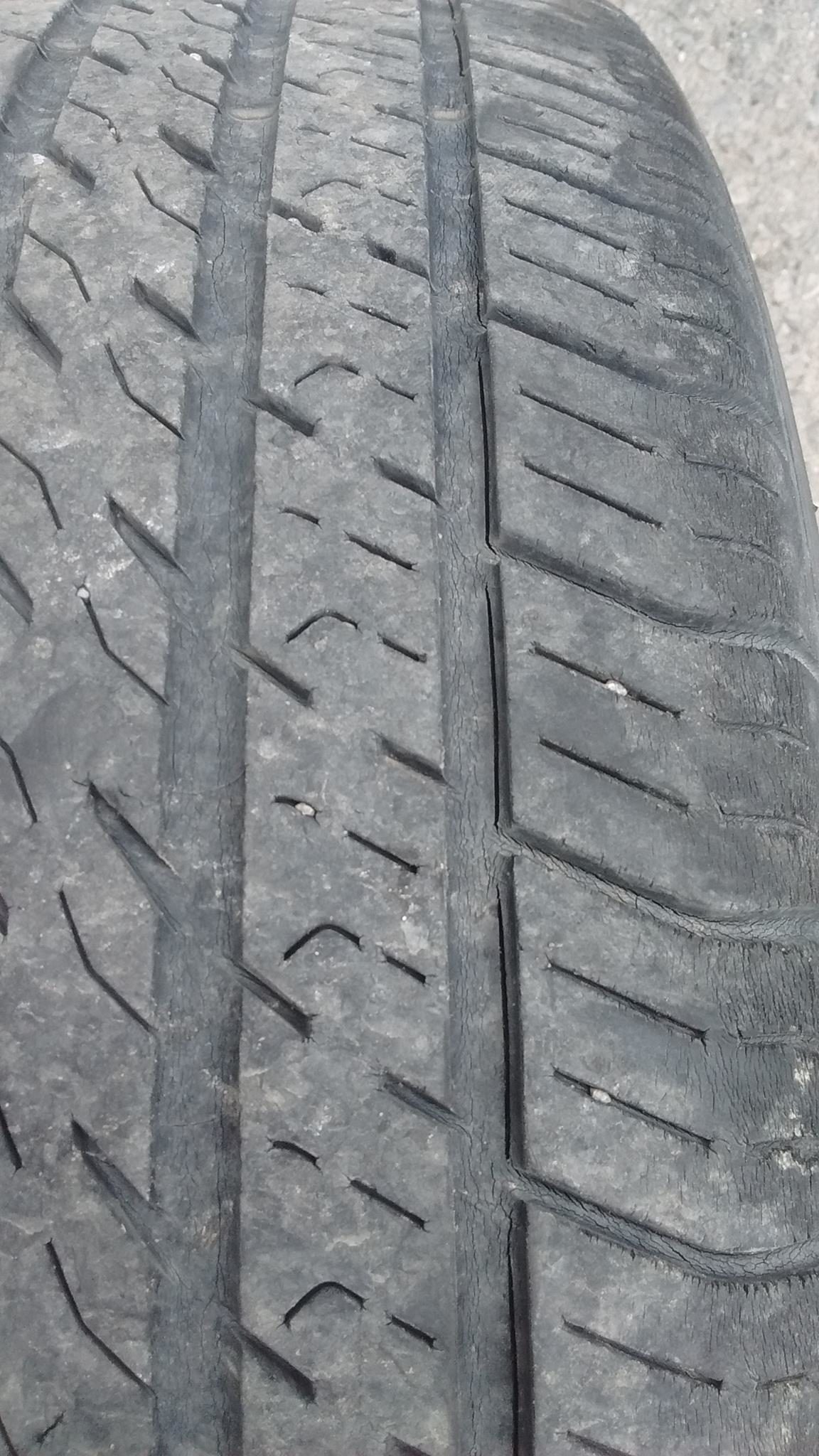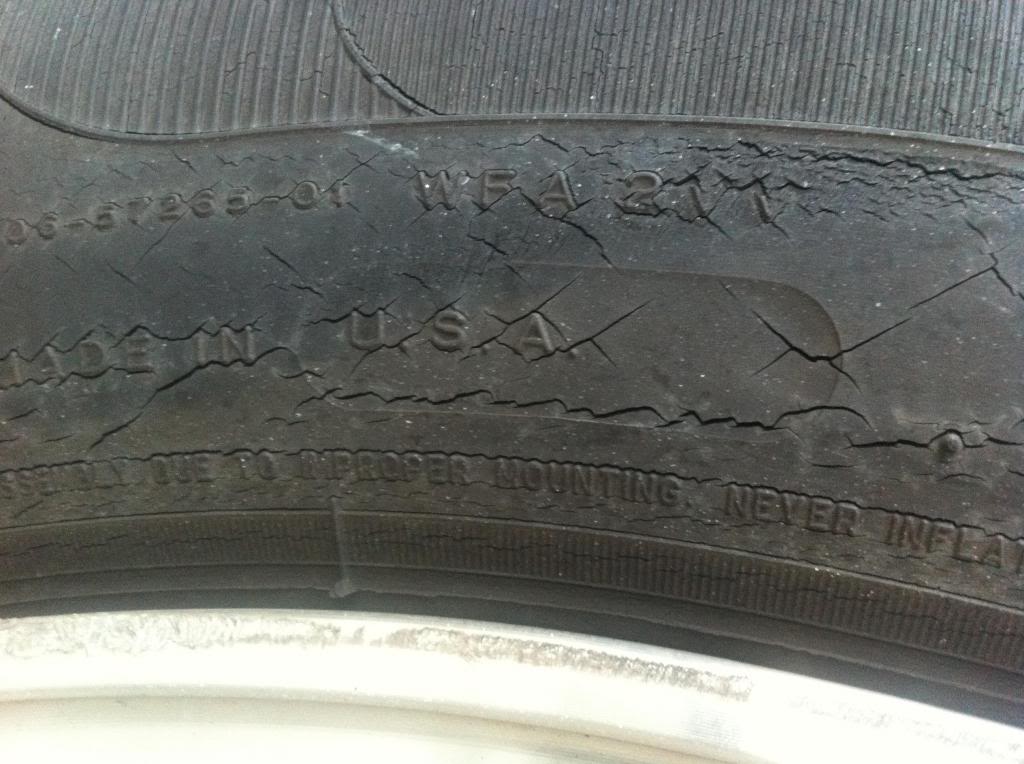I found a 1.5' long crack between the tread of my tire (6/32 remaining - about 4 years old since it was made/3 years on truck). It looks kind of deep - goes lengthwise around the tire. Some web surfing suggests this 'happens to Michelin more than other brands.' Anyone else have the same.
Michelin Tire Cracking Between Treads
Bradley Jando | Monday 1st March 2021 3:35pm
Tyres are highly engineered pieces of equipment and they’re arguably one of the most important parts of your car. Without them, your car wouldn't be able to move. However, tyres don’t last forever, and there are some signs of wear and tear that you need to look out for, including cracking.
Tire monkey checking in. Bad news for you, whoever said it was 4 years old lied to you. The pilot sport a/s has been discontinued more than 4years ago, Michelin website lists official discontinuation at may of 2009. In addition, this edge cracking is a known problem with them and the major reason they were discontinued. When it comes to cleaning tires, we recommend you follow this advice from our friends at Michelin: “Avoid the use of petroleum based tire cleaning products as they can exhaust the tire's oxidation and weathering agents within the rubber compounds, resulting in cracking. Put another way, cracking of rubber is to be expected as the tire gets old. But the real problem is not what you can see on the outside. It’s the rubber on the inside that’s holding the tire together.
But why have your tyres cracked, and is there a way to fix them?
What causes tyres to crack?
There are a number of components that help to make tyres strong enough to hold the weight of your car and enable them to keep their shape under pressure. These components include plies (the fibres inside the tyre that give it some flexibility while maintaining its structure) and beads (steel that’s coated in rubber to create a seal between the tyre and the wheel rim).
The rubber on the outside of the tyre is made up of lots of polymers that are knitted together to form molecules. Tyre cracking is caused by these bonds breaking down. But what is it that causes these bonds to weaken in the first place?
UV rays/ extreme heat
The polymers in the tyre can expand in the heat and contract in the cold. This constant movement can weaken the bonds over time, which is when cracks begin to appear. UV rays can also have the same effect. UV rays are one of the biggest causes of cracked tyres, because it’s nearly impossible for most people to keep their car in a garage or parked in the shade all the time. However, recent technological advancements mean that you can actually paint UV-resistant paint (or sprays) in your tyres in order to protect them from UV rays.
Age
As your tyres get older, the polymers naturally weaken and begin to break down. This causes your tyres to harden and become brittle - and this loss of elasticity can mean the tyres crack. Even if your car hasn’t been driven for a few years and is stored in a garage, the tyres can still weaken and crack.

It’s actually more beneficial to drive your car every now and then instead of leaving it parked. The chemical that prevents the tyre from drying out and cracking is released when the tyre is moving. Therefore, if the car is parked for a long time, this chemical won’t be able to work efficiently.
Water
Rubber is mainly waterproof, however water can still permeate the tyre after driving on wet roads for a prolonged period of time. This water can then have the effect of either sloshing around inside the tyre – which wears it down from the inside – or having a similar effect to potholes. As the water expands and contracts in partial cracks of your tyres, it makes them larger.
Degradation
Tyres are made of rubber, which is an organic material that’s taken from trees. This makes them biodegradable and no amount of chemicals will stop your tyres from naturally degrading over time.
Certain chemicals and compounds are applied when your tyres are made to reinforce them and slow down degradation, however these won’t work forever.
Tyre pressure
Over or under pressurised tyres can become cracked. With under pressurised tyres, more heat is created when you’re driving. This is because more of the surface of an underinflated tyre is in contact with the road, which creates more friction. Over pressurised tyres can add extra stress to the tyre wall and cause bulging.
You can check whether your tyres are the right pressure using a pressure meter, or through our tyre pressure checking tool. Simply input your car’s registration number and you’ll see what your recommended tyre pressure is.
Are cracked tyres dangerous?
You should avoid driving with cracked tyres. This is because the tyre’s rigidity and strength has been compromised and you could experience a blowout while driving.
If you notice cracks around your tyres, you should take your car to a garage and have new ones fitted.
Are cracked tyres an MOT failure?
An MOT test will involve all four tyres being checked for damage and general wear and tear. When you take your car for its test, the tyres should have a tread depth of at least 1.6mm (the legal minimum) and there shouldn’t be any tears, bulges, or cracks around the tyre.
Your car may fail its MOT if it’s determined that the tyres aren’t safe to drive with. If your car does pass its MOT, it could be worth determining with the garage the state of your tyres, as they may be borderline or could need to be replaced soon. The garage will be able to tell you the tyres’ tread and what condition they’re in.
How to fix cracked tyres
It’s not recommended that you try to fix your cracked tyres as their structure has been permanently weakened and no amount of chemicals will be able to bring your tyre back. However, there are preventative measures that you can put in place when your tyres are in good condition to prevent them from cracking.
How to make tyres last longer

You should ensure that your tyres are inflated to the manufacturer’s recommendations and ensure that you’re driving your vehicle regularly. Also, where possible, try to park in the shade or in a garage.
You could apply a tyre protector to your tyres regularly. There are lots of brands that create these solutions, which are made to protect the rubber from UV and environmental damage as well as repel dust, dirt, and water. Just make sure that you use a water based solution, as harsh chemicals can speed up the cracking process.
Michelin Tire Cracking Chart
Once the tyres have begun to crack, they are still okay to drive with if the cracks aren’t too big or deep. However, the fungus that causes dry rot in wood, Serpula lacrymans, could start to attack the rubber on your tyres. By keeping your tyres clean, you’ll help to prevent the fungus from spreading further, so clean your tyres regularly with warm, soapy water.
Having a qualified professional check your car tyres can help them to last longer. Come down to your local Kwik Fit centre for a free tyre check.
Featured Articles
Coronavirus - Car Safety Checks You Can Do At Home
Michelin Tire Cracking Sidewall
Wednesday 1st April 2020
With the recent Coronavirus outbreak many people are working from home and rarely using their cars. At Kwik Fit we want to offer some some hints and tips on how to maintain your car during this uncertain time.
Looking After Your Car Battery During Lockdown
Tuesday 31st March 2020
With the uncertainty surrounding the current Coronavirus situation many drivers are worried about how to look after their car batteries. Kwik Fit offers some advice to help to ease your concerns.
Archive


Michelin Tire Cracking Chart
Topics
Michelin Tire Cracking Warranty
Tires take a serious beating—constant 'stretching' as they roll along the road, exposure to harsh chemicals (gasoline, oil, acid, etc.), UV rays and heat. That rubber is suffering so that you can travel! Almost all tires will begin to exhibit small cracks in the sidewall after a short period of time. Is it time to worry?
The outer layer of rubber on the sidewall is simply a sealing layer to keep the elements away from the inner (structural) part of the tire—in other words, those unsightly cracks are purely cosmetic. If your tires start to get really deep cracks after 3-5 years, you might consider replacing them for peace of mind. If you haven't worn out a set of tires in 5-8 years, it's worth replacing them for safety's sake, even if there is still good tread left on the tires.
It is important to note that recreational vehicles—like your VW camper, maybe?—are more subject to tire cracking than everyday drivers. Long periods of 'sitting' causes the rubber to dry out, and when you take your camper out for a drive, the rubber 'splits' as it gets worked on the road. Again, this is nothing to worry about unless the cracks are exceptionally deep.
The bottom line is this: In almost every case we've seen, you do not need to worry—you just need to get out and camp!